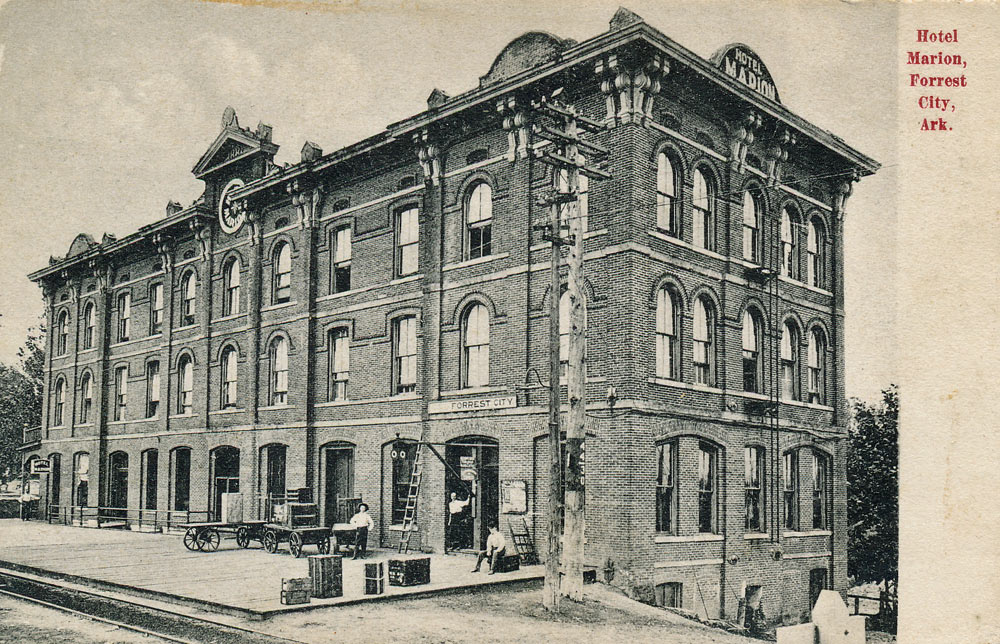
In 1885, construction started in Forrest City, Arkansas, on an imposing brick structure located on the south side of the Memphis & Little Rock mainline. The new building was three stories tall with a basement which was essentially a fourth floor when viewed from the south side street level. Forty rooms were in the upper two floors, and the hotel restaurant was described as having a "...bill of fare which includes the best the market can afford in the way of luxuries, Memphis being frequently called upon to supply the culinary department with choice brands of dainty and digestible edibles." The opening of Forrest City's newest hotel, the Avery Hotel, was celebrated with an Opening Ball on the evening of April 28, 1886. As might be expected, all of the business and civic leaders of Forrest City were in attendance, as well as participants from Memphis, Brinkley and Little Rock.
The financial interest of the Memphis & Little Rock Railroad in the Avery Hotel is uncertain. The hotel was located on railroad right of way, but the M&LR was in receivership at the time the hotel was being built, and thus not in a financial position to provide much more than the land itself. However, two of the prominent participants at the Opening Ball were Mr. and Mrs. Rudolph Fink. Rudolph Fink, headquartered in Memphis, was the general manager of the M&LR railroad as well as agent for the trustees. Contemporary M&LR timetables do not indicate any regularly scheduled meal stops at Forrest City.
Althought originally opened as the Avery Hotel, the business changed hands by 1898-1899 and was known as the Belser Hotel. By 1901 the business was known as the Marion Hotel, Mrs. Pauline Goddard, proprietor. The Marion Hotel name was continued for almost 50 years. In the meantime, the Memphis & Little Rock Railroad became the Choctaw & Memphis, then the Choctaw, Oklahoma & Gulf, and finally the Chicago, Rock Island & Pacific, more commonly known as the Rock Island.
The July 24, 1908 issue of Railway Age indicated that Rock Island would soon award a contract for a new passenger station in Forrest City. It is possible that this contract involved the movement of Rock Island ticket and telegraph offices from a prior depot into the hotel, or it could simply have been a remodeling of the existing facilities in the hotel. Postcards circa 1910 show the Rock Island passenger facilities in place in the northwest corner of the hotel. By the time of the 1916 Interstate Commerce Commission valuation, the hotel was actually owned by the Rock Island. Rock Island leased out the second and third floor for continued hotel use, along with the east end of the first floor for the hotel lobby and restaurant. The west end of the first floor housed the railroad ticket office and waiting room as well as the office for the express company operating over the Rock Island.

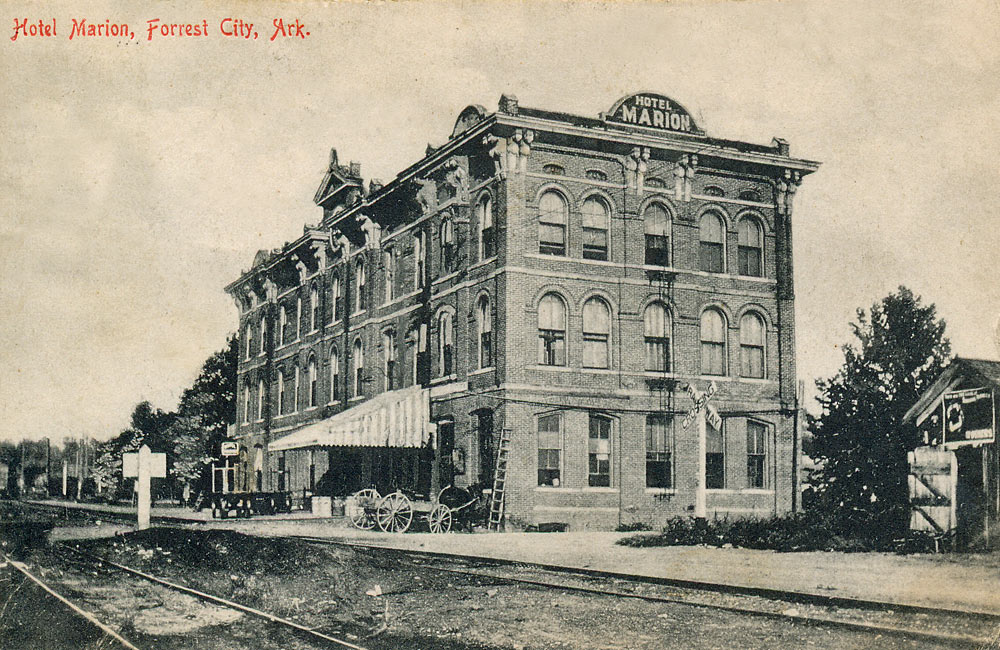
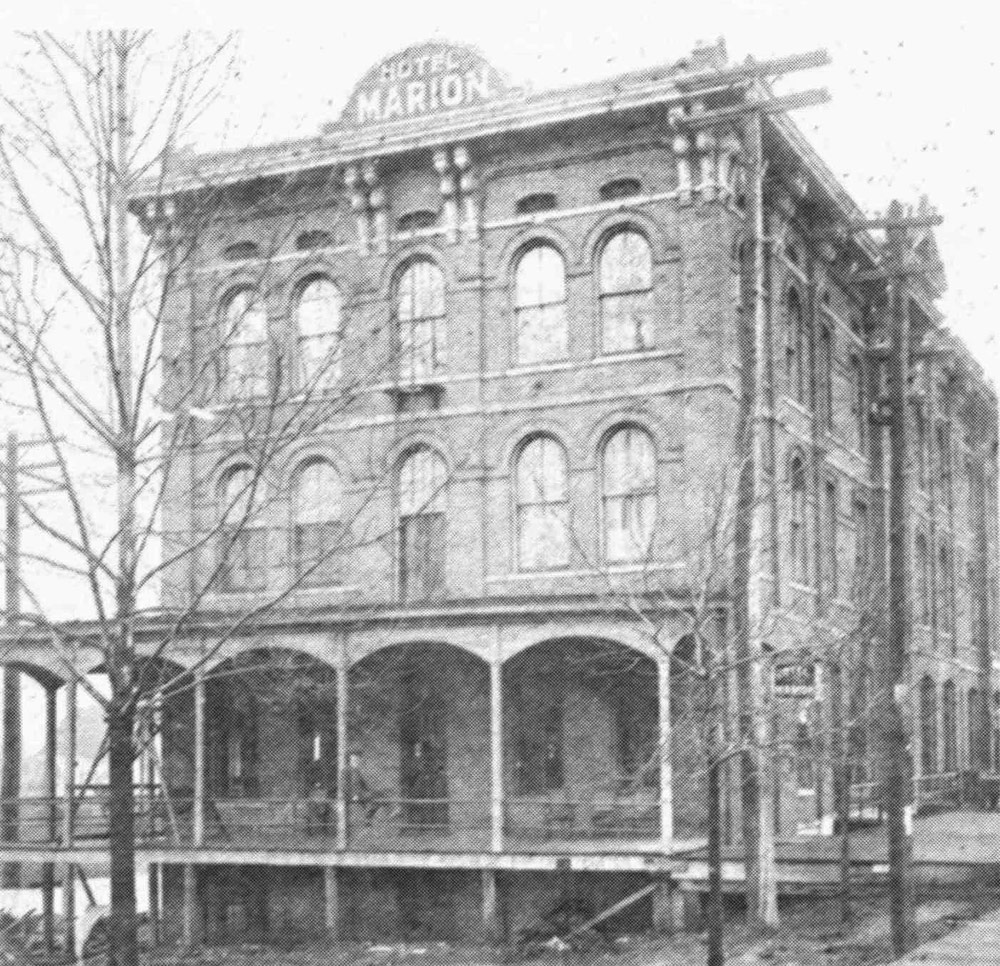
A view of the eastern end of the Marion Hotel showing the entrance to the hotel lobby on the northeast corner of the building, and a covered porch area on the end of the building.
Beginning about 1907, Rock Island developed a relationship with the John J. Grier Hotel Company, whereby Grier operated hotels, dining rooms and lunch rooms along the railroad, in similar manner to the more famous business affiliation of the Santa Fe Railroad and the Fred Harvey Company. By 1910, Grier was operating a hotel and elaborate eating house at Booneville, and a lunchroom was also operated at Little Rock. For reasons currently unknown, the Marion Hotel at Forrest City did not come under Grier management until early 1917. At that time, the Forrest City hotel began to be listed in Rock Island timetables, offering both hotel facilities and a dining room, although no Rock Island passenger trains were scheduled to stop at Forrest City for meals. Listing for the dining room disappeared in 1920; this might reflect closing of the dining room, or a leasing of the operation to an operator other than the Grier Hotel Co.

Cotton Belt passenger trains began passing through Forrest City on April 1, 1912, as a result of a trackage rights agreement with Rock Island between Brinkley and Memphis. Rock Island's employee timetable of that date shows all trains stopping at the Iron Mountain crossing at Forrest City, but not all Cotton Belt trains stopping at Forrest City Union Station. In fact, Forrest City was not identified as a station in Cotton Belt public timetables until 1928, and Cotton Belt trains were prohibited from carrying local passengers between any points that might be competitive with Rock Island's own service.
In 1919, the United States Railroad Administration began consolidating what they regarded as duplicate operations to streamline the rail industry for wartime traffic during the time the railroads were under government control. Rock Island and Missouri Pacific passenger operations were consolidated into the Rock Island facility in the Marion Hotel and the building began to be identified as Forrest City Union Station.
In July 1922, an incident occurred at the Marion which resulted in legal proceedings being brought against John J. Grier Hotel Company [44 Ark. 159]. On July 31, Mr. and Mrs. J.W. Stevenson of Memphis registered at the hotel, paid for their accommodations, and were assigned to a room which they occupied that night. On the morning of August 1, the manager of the hotel came to the room and ordered the couple out of the hotel, using abusive and insulting language which implied adultery, although in fact, the plaintiffs had been legally married for 20 years. The couple was escorted to the lobby of the hotel, where in the presence of numerous onlookers, the manager again used insulting language, leaving the impression that the plaintiffs had been guilty of adultery in the defendant's hotel. A suit was filed in St. Francis Circuit Court claiming that the hotel manager had slandered Mrs. Stevenson's character and caused her to be the object of public shame and humiliation, as well as being ridiculed by all who witnessed the eviction from the hotel.
Rock Island attorney Thomas Buzbee defended the hotel and claimed that the allegations were not sufficient to constitute a cause of action. Judge J.M. Jackson agreed, and that ruling was then appealed to the Arkansas Supreme Court. The Supreme Court on May 21, 1923 overruled the Circuit Court and the case was returned for trial. The end result is unknown, but was likely an out of court settlement by the Hotel Company.
In 1925 and 1926, local citizens in both Brinkley and Hoxie petitioned the Arkansas Railroad Commission to force the railroads to construct umbrella sheds at those union stations. It is likely that a similar effort was made at Forrest City, and some trackside sheds were erected to shield passengers from rain. In the postcard below, postmarked 1932, sheds have been erected extending west from the station to the Missouri Pacific crossing, and the former porch area of the hotel had been replaced with a single story addition. This postcard was also published by J.T. Sanders.
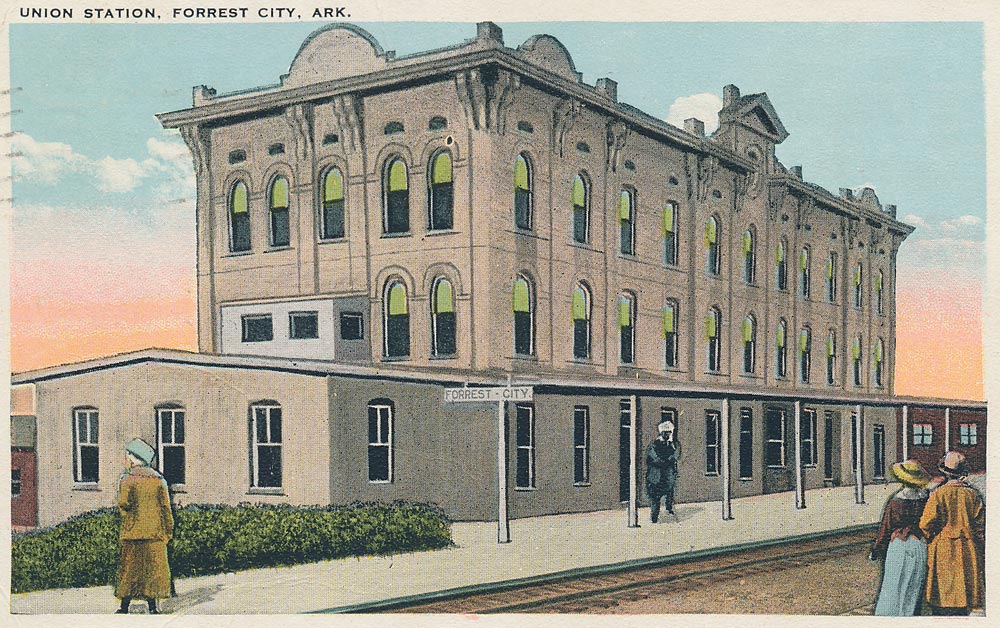
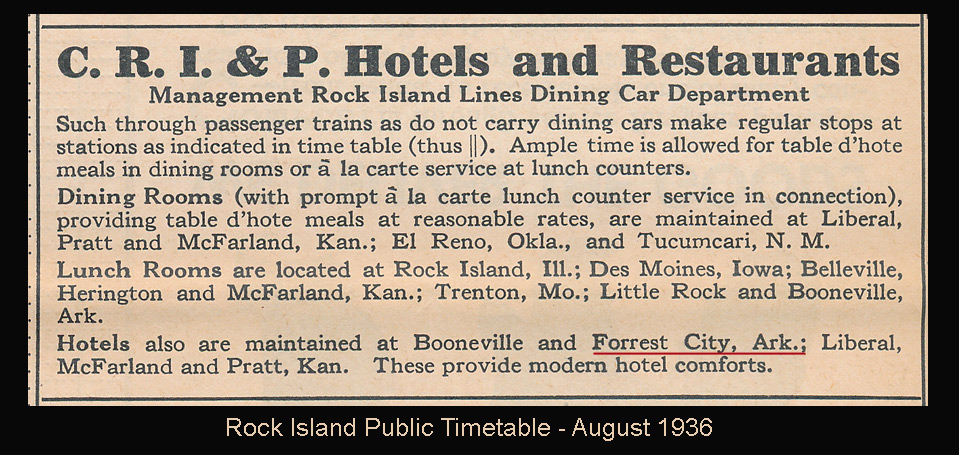
John J. Grier Hotel Company's Rock Island contract passed to Van-Noy Interstate Railroad News Company in 1923, and in 1929 the Rock Island Dining Car Department took over management of the remaining hotels and eating houses. The effects of the Great Depression, reductions in local train service, and the addition of dining cars to all major trains resulted in the sale or closure of many eating houses. Other than timetable advertising, little evidence remains from this period of Rock Island's management of hotel operations.

Note paper for Rock Island Hotel Service provides the name of all five hotels still in service. Both of the Arkansas hotels (the Marion and the Petit Jean) were last listed in the August 1936 timetable. The Cimarron last appeared in July 1937 timetable and both the Modoc and Ninnescah were deleted after the June 1938 timetable. Rock Island operated hotel and eating house operations ended at all remaining locations by late 1938.

The July 1935 Rock Island Hotel Service menu provides an example of the fare that was offered near the end of railroad hotel operations. It is unknown whether this menu was specific to a certain hotel, or whether it was used in all of the hotels which still offered an on-site restaurant.
Forrest City's Marion Hotel last appeared in the August 1936 Rock Island timetable, and railroad documents indicate that most of the building was leased for independent operation (still known as the Marion Hotel) on April 1, 1937 to W.N. Landers and A.B. Wolfe. Rock Island lease documents detail the other agreements that were in effect, including MoPac's joint use of the station and the lease of space to Railway Express Agency.
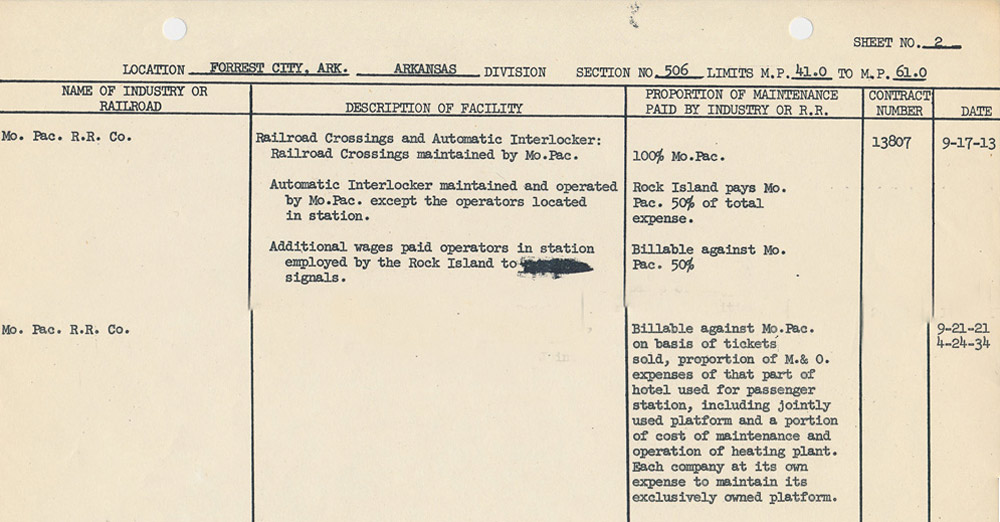
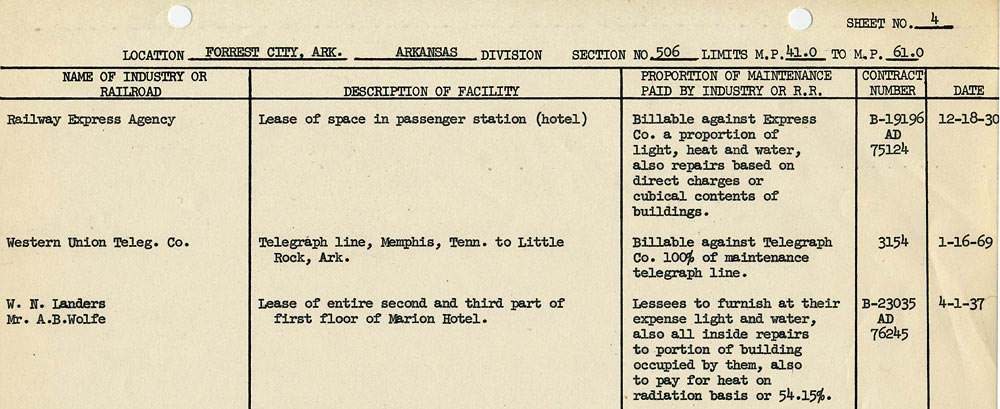
In the classic view below, the eastbound Choctaw Rocket is making its Forrest City station stop. Note the Rock Island freight house on the right side of the photograph. This building would later be modified to serve as the passenger station. The semaphore train order signal is located on the north side of the mainline. At this time, its uncertain whether the train order office was still in the hotel or had been moved to the freight station. The "new" east side extension of the hotel building is visible, along with part of a Marion Hotel sign and nicely maintained grounds.
Accurately dating this photograph is a challenge. From November 1940 until January 1949, eastbound train 52 passed through Forrest City in the early morning (6:40am). After January 1949, the train passed through Forrest City in the late afternoon (6:30pm). Given the morning sun reflecting off the nose of the locomotive, and what appears to be the original Choctaw Rocket consist, a "best guess" photograph date is 1941-1942, prior to the time that 200 series coaches were added to the Rocket to expand capacity for wartime travel.
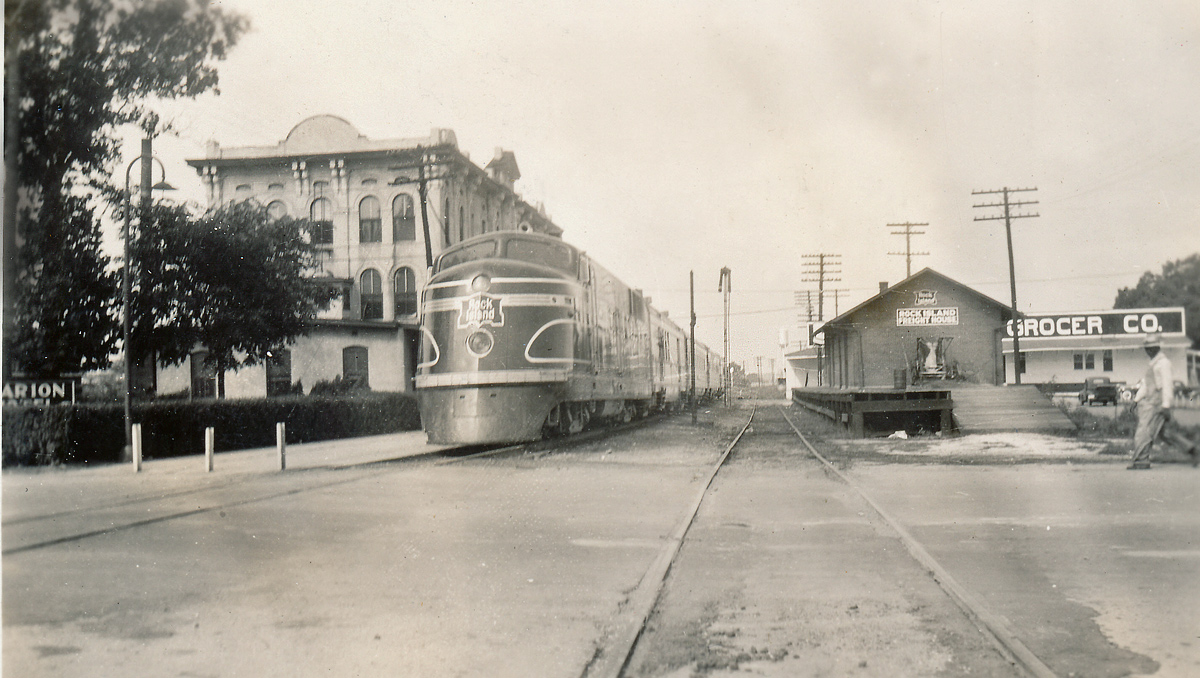
The length of time during which the Marion Hotel served as a passenger station remains to be determined. Missouri Pacific's last passenger train service through Forrest City was local passenger trains 315-318, operating between Helena, Marianna and Wynne. These trains were discontinued in late 1938, although Missouri Pacific bus operations continued into the 1950s and Official Guide entries as late as January 1957 show Rock Island passenger trains and Missouri Pacific buses using the same station at Forrest City.

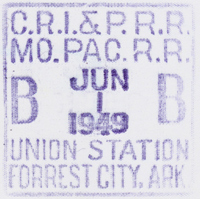
The Hotel Red Book listing for 1944 (left)identifies Newton Landers as the manager, with room rates starting at $1.00 per night under the European plan (room rental for room only, not meals). The ticket validator (right) was used to date stamp tickets sold at Forrest City Union Station. In addition to the Rock Island and Missouri Pacific names on the dater, Cotton Belt trains also stopped at this station until Cotton Belt passenger service to Memphis ended in October 1952.
.
The closure date of the Marion Hotel is also uncertain but appears to have occurred in the late 1940s. The property was still listed in the 1945 edition of the Hotel Red Book but had disappeared by the time of the 1950 edition. An exchange between Rock Island Arkansas Division Superintendent C.G. Adams and signal maintainer L.E. Scoles suggests that part of the hotel lobby area had already been closed by June 1944.
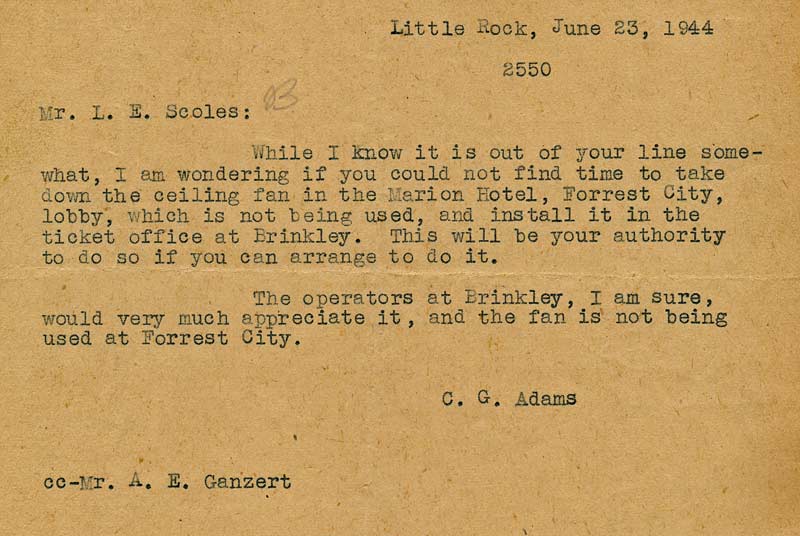
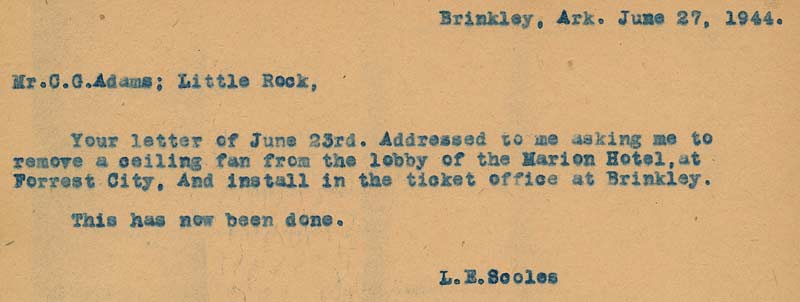
In 1953, Rock Island began a program of replacing semaphore train order signals with flashing light signals. Forrest City was one of the first few Arkansas locations to receive these signals, with a new style signal installed prior to 1956. Perhaps to aid in visibility, this signal was placed on the south side of the mainline, on the passenger platform adjacent to the Marion Hotel. In August 1953, the Choctaw passenger train was replaced with rail diesel car (RDC) service known as the Choctaw Rockette. At an unknown date in the early to mid-1950s, the west end of the Rock Island freight station was remodeled to accommodate both a train order office/ticket office, and a small waiting room for passengers. Rock Island moved out of the Marion Hotel, and in late 1958, the historic old building was demolished.
In the demolition photographs, the new train order signal is visible in the distance, along with baggage wagons stored at the east end of the old hotel. The framing to the right of the hotel building supported the sheds extending west toward the Mopac crossing. Also note the motor car parked next to the telegraph pole, and a porcelain Railway Express Agency sign still mounted to the left of the door closest to the photographer. The wooden sign hanging from the shed supports with an arrow directing people to the east end of the building says something about "used lumber for sale", perhaps referring to a later business after hotel operations ceased. Note the proximity of the MP crossing, and that the sheds ran parallel to the MP tracks as well as running along the RI track westbound,
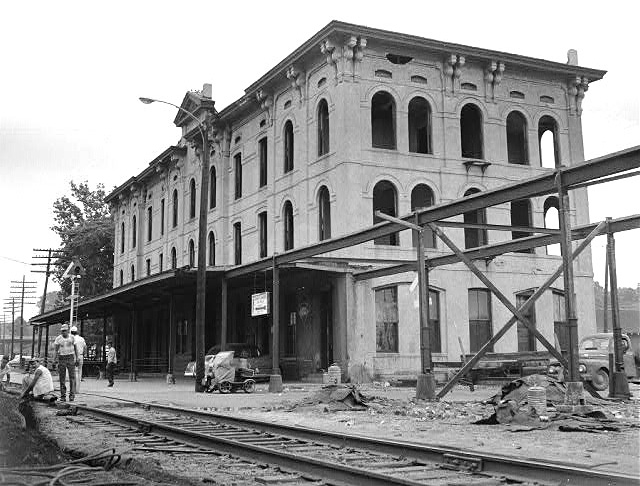
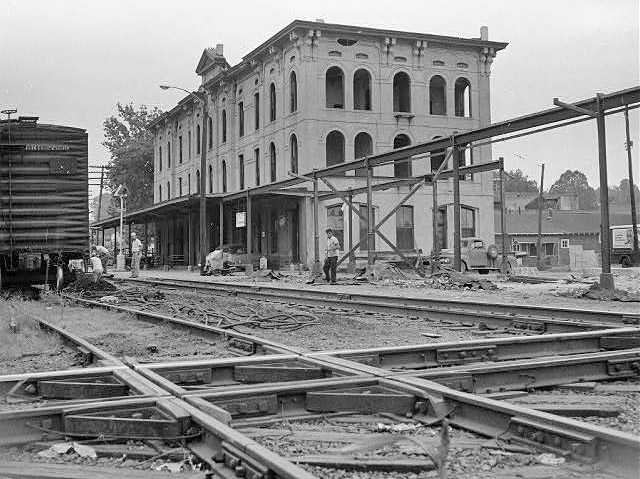
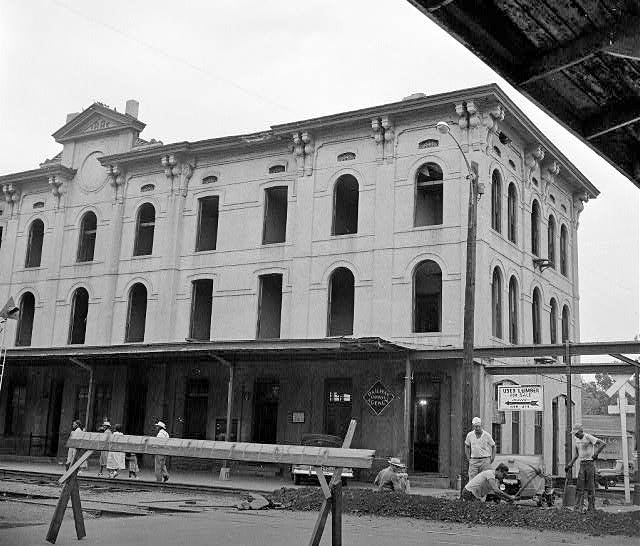

Ed Wojtas, Rock Island company photographer and employee magazine editor, captured these classic views of Rock Island trains 23 and 24 at Forrest City, circa 1960. The daytime views show "Budd car" 9002 about an hour after its departure from Memphis Central Station, scheduled out of Forrest City at 11:36am. The evening view of train 24 (with 9003) is likely a late operation; normal schedule time at Forrest City was 5:40pm. By this time, the Marion Hotel was only a memory, and all Rock Island operations were located in the former freight depot. After the end of Rock Island passenger service in November 1967, this station remained in use as a train order office until the Rock Island ceased operation in March 1980.
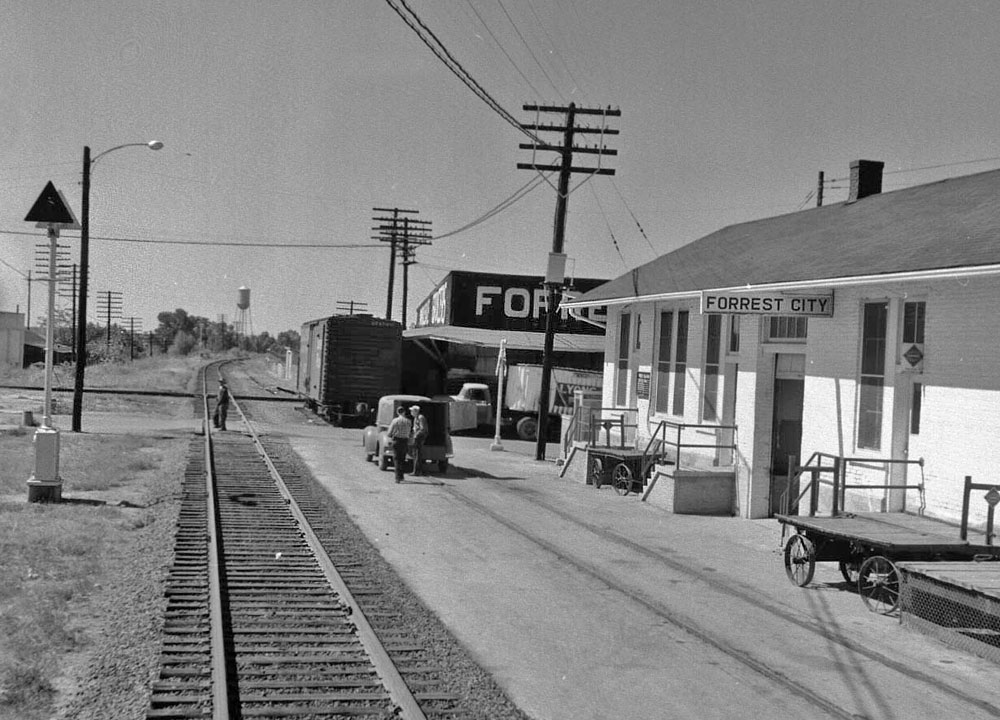


Cotton Belt assumed control of trackage between Memphis and Brinkley on March 23, 1980. As the Rock Island prepared to cease operations, Rock Island jobs at Forrest City were abolished and the station was closed. Cotton Belt utilized train order offices at Brinkley and Kentucky Street-Memphis, but no longer needed an intermediate office at Forrest City. Soon after Cotton Belt's purchase of the Brinkley-Memphis segment of Rock Island trackage was finalized, the Rock Island freight depot was demolished.
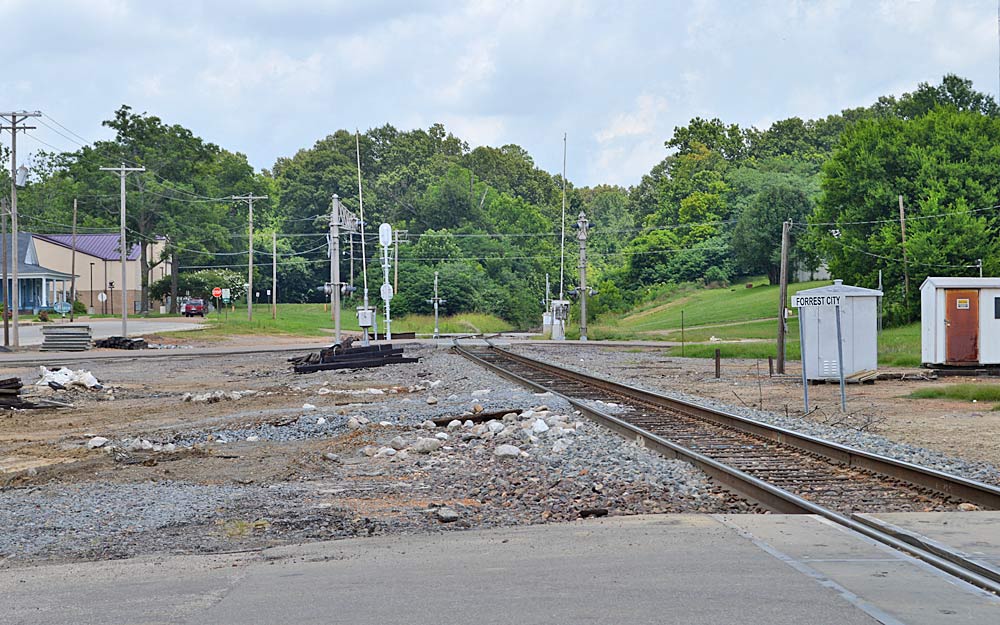
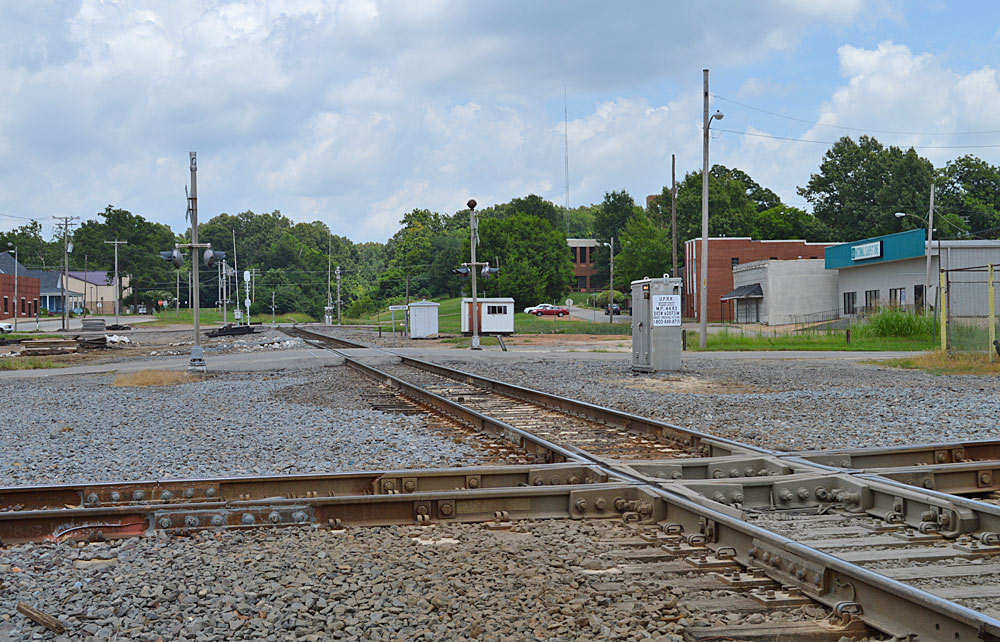
These photographs, facing east and taken in July 2014, shows how progress has not been kind to the historical fabric of Forrest City. The road crossing is the same from which the photograph of RDC 9002 was taken; the rubble to the left of the main line represents the Rock Island freight station, and the empty area on the opposite side of the track is where the Marion Hotel was located. The single main track is all that remains of the Rock Island trackage, and the former MP crossing is still in operation, located one block west.